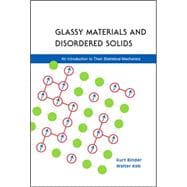
What is included with this book?
| Preface | p. v |
| Introduction | p. 1 |
| Models of Disordered Matter: A Brief Overview | p. 1 |
| General Concepts on the Statistical Mechanics of Disordered Matter | p. 13 |
| Lattice Models | p. 13 |
| Averaging in Random Systems: Quenched versus Annealed Disorder | p. 17 |
| "Symmetry Breaking" and "Ergodicity Breaking" | p. 20 |
| Configurational Entropy versus "Complexity", and the Kauzmann Paradox | p. 25 |
| Structure and Dynamics of Disordered Matter | p. 35 |
| Pair Distribution Functions and the Static Structure Factor | p. 35 |
| Topological Disorder and Bond Orientational Correlations | p. 51 |
| General Aspects of Dynamic Correlation Functions and Transport Properties | p. 63 |
| Models of Disordered Structures | p. 79 |
| Random Walks: A Simple Model for the Configurations of Flexible Polymers | p. 79 |
| Percolation: A First Example of a Fractal Structure | p. 94 |
| The Percolation Probability and Percolation Threshold | p. 94 |
| Diluted Magnets and Critical Exponents | p. 98 |
| The Fractal Dimensionality and the Concept of Finite Size Scaling | p. 104 |
| Scaling of the Cluster Size Distribution | p. 106 |
| Percolation for Low and High Lattice Dimensions | p. 109 |
| Rigidity Percolation | p. 113 |
| Other Fractals (Diffusion-Limited Aggregation, Random Surfaces, etc.) | p. 116 |
| General Concepts on Fractal Geometry | p. 116 |
| Diffusion-Limited Aggregation | p. 120 |
| Growth of Random Interfaces | p. 122 |
| Random Close Packing | p. 124 |
| Continuous Random Networks | p. 132 |
| Chemically Realistic Models of Structural Glasses | p. 139 |
| General Concepts and Physical Properties of Disordered Matter | p. 165 |
| The Rouse Model for Polymer Dynamics: A Simple Example for the Consequences of the Random Walk Picture | p. 165 |
| Application of the Percolation Problem to Physical Systems | p. 178 |
| Percolation Conductivity and a Naive Treatment of the Elasticity of Polymer Networks | p. 178 |
| Excitations of Diluted Magnets Near the Percolation Threshold | p. 183 |
| Effective Medium Theory | p. 188 |
| Elementary Excitations of Fractal Structures | p. 190 |
| Diffusion on a Percolation Cluster: The "Ant in the Labyrinth" | p. 190 |
| The Spectral Dimension and Fracton Excitations | p. 193 |
| The Sol-Gel Transition Revisited | p. 198 |
| Physical Properties of Amorphous Solids | p. 202 |
| Two-Level Systems | p. 203 |
| Anomalies of Glasses at Intermediate Temperatures: Excess Specific Heat, Thermal Conductivity Plateau, and Boson Peak | p. 210 |
| Spin Glasses | p. 221 |
| Some Experimental Facts about Spin Glasses: Systems and Physical Properties | p. 222 |
| Theoretical Models | p. 233 |
| The Replica Method and the Mean Field Theory of the Ising Spin Glass | p. 237 |
| Replica Symmetry Breaking | p. 245 |
| Spin Glasses Beyond Mean Field Theory | p. 255 |
| Variants and Extensions of Spin Glasses | p. 263 |
| p-Spin Interaction Spin Glasses and the Random Energy Model | p. 263 |
| Potts Glasses | p. 264 |
| Quadrupolar Glasses as Models for Diluted Molecular Crystals | p. 276 |
| Atomistically Realistic Models of Diluted Molecular Crystals | p. 281 |
| Spin Models with Quenched Random Fields | p. 285 |
| Supercooled Liquids and the Glass Transition | p. 311 |
| Phenomenology of Glass-Forming Systems | p. 312 |
| Models for Slow Relaxation | p. 331 |
| The Theory of Adam and Gibbs | p. 332 |
| The Free Volume Theory | p. 338 |
| Kinetically Constrained Models | p. 345 |
| The Mode-Coupling Theory of the Glass Transition | p. 359 |
| The Zwanzig-Mori Projection Operator Formalism | p. 360 |
| The Mode-Coupling Approximations | p. 364 |
| The Mode-Coupling Theory of the Glass Transition | p. 366 |
| Predictions of Mode-Coupling Theory | p. 375 |
| The Relaxation Dynamics of Glass-Forming Liquids and Test of the Predictions of MCT | p. 385 |
| Concluding Remarks on Mode-Coupling Theory | p. 412 |
| Index | p. 431 |
| Table of Contents provided by Ingram. All Rights Reserved. |
The New copy of this book will include any supplemental materials advertised. Please check the title of the book to determine if it should include any access cards, study guides, lab manuals, CDs, etc.
The Used, Rental and eBook copies of this book are not guaranteed to include any supplemental materials. Typically, only the book itself is included. This is true even if the title states it includes any access cards, study guides, lab manuals, CDs, etc.